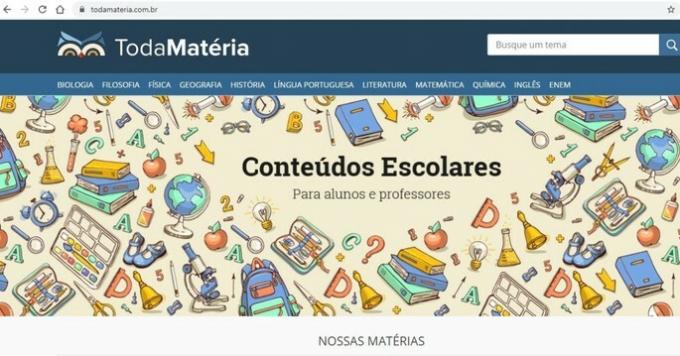A site reference is the identification of the author, title of the article, site name, year, link and access date of an Internet text cited in your academic work.
The presentation of this information is different depending on the types of websites. A newspaper website, for example, is not referred to in the same way as a regular website or a home page (the homepage of a website).
Check out what the All Matter prepared to help you reference each of these types of sites correctly, in accordance with the standards of the ABNT (Brazilian Association of Technical Standards).
Newspaper Sites

Learn how to reference text from newspaper sites.
Journal website reference with author
Last name. Title of the article. Newspaper name, city of publication (if any), day, month and year. Section (if any). Available in:. Accessed in: day, month and year.
Example:
ZALUAR, Alba. There is no final solution. The globe, Sept. 24 2019. Opinion. Available in: https://oglobo.globo.com/opiniao/artigo-nao-ha-solucao-final-23969074. Accessed on: 25 sep. 2019.
Journal site reference without an author
TITLE of the matter. Newspaper name, city of publication (if any), day, month and year. Section (if any). Available in:. Accessed in: day, month and year.
Example:
Palmeirense mother wins the 'Fan of the Year' award at FIFA The Best. The globe, September 23 2019. Sports. Available in: https://oglobo.globo.com/esportes/mae-palmeirense-vence-premio-torcedor-do-ano-no-fifa-the-best-23968259. Accessed on: 25 sep. 2019.
Periodic publication sites in electronic media

Periodic publication site reference with author
Last name. Title of the article. site name, year. Available in:. Accessed in: day, month and year.
Example:
MUNIZ, Carla. Dostoevsky: biography and summary of the main works. All Matter, 2019. Available in: https://www.todamateria.com.br/dostoievski/. Accessed on: 25 sep. 2019.
Periodic publication site reference without an author
TITLE of the matter. site name, year. Available in:. Accessed in: day, month and year.
Example:
HOW to choose a Suitcase. cheap backpack, 2019. Available in: https://mochilaobarato.com.br/escolher-mala-de-bordo/. Accessed on: 25 sep. 2019.
Home page

AUTHOR OR ORGANIZATION. site name, year. Menu (description). Available in:. Accessed in: day, month and year.
Example:
7 DEGREES. All Matter, 2019. School content for students and teachers. Available at: www.todamateria.com.br. Accessed on: 25 sep. 2019.
Document links available online

AUTHOR OR ORGANIZATION. Title. City: Responsible for publication, year. Total pages. Available in:. Accessed in: day, month and year.
Example:
CONSOLI, R. THE. G. B.; OLIVEIRA, R. L. Main mosquitoes of health importance in Brazil. Rio de Janeiro: Fiocruz Publisher, 1994. Available in: http://books.scielo.org/id/th/pdf/consoli-9788575412909.pdf. Accessed on: 30 sep. 2019.
Encyclopedia and Dictionary Website Reference

TITLE of the entry or concept. In: NAME of the encyclopedia or dictionary. City: Responsible for the publication/publisher, year. Available in:. Accessed in: day, month and year.
Example:
REFERENCE. In: DICIO: Online Portuguese Dictionary. 7 DEGREES, c2019. Available in: https://www.dicio.com.br/referencia/. Accessed on: 26 sep. 2019.
Indispensable information when referring to a website
When referring to the website you mentioned in your text, keep in mind some relevant information.
- Contents that you just consulted, but not cited, do not need to be part of the bibliographic references.
- The email address must always be preceded by “Available at:”.
- The day on which you accessed the referred website must be indicated after the information “Accessed on:”.
- When entering dates, the month must have three letters (except for the month of May) and the year, 4 numbers. For months, the first three letters + period must be used. Example: for the month of March, the sea is used.
- References must be arranged in alphabetical order. If the information starts with a definite article or an indefinite article, they should not be taken into account in the ordering.
- The name of the website, newspaper or document must always be highlighted with a typographic feature (bold, italics or underlining), which must be the same throughout the reference list.
- If a text does not have the publication date, use the year of copyright of the website, preceded by a c. Example: c2019. This information is usually at the bottom of the website page and may be indicated by the word copyright or by the symbol ©.
If a text does not contain information about the city where it was written, the state or country can be indicated, as long as this indication is included in the content.
Why is including site referrals important?
One of the main advantages of indicating the reference of the sites mentioned during the execution of a work is to show that the conclusions were based on research and investigations.
In addition, it is also very important to give credit to those who developed the aforementioned contents, ideas and conclusions.
By adopting a fair and honest posture, you can be free from allegations of plagiarism.
Mechanism that automatically generates bibliographic references
MORE, Online Mechanism for References, is a mechanism that streamlines the process of creating bibliographic references.
Just enter information about the essential elements of the cited content (year, title, author, etc.) and MORE generates the corresponding bibliographic reference.
To learn more about academic papers, read also:
- Direct and indirect citation
- Apud or citation citation
- website quote
- How to make ABNT work cover (model and guide)
- ABNT cover sheet
- Acknowledgments from TCC (ready model and examples)
- How to make a summary (ABNT rules)
